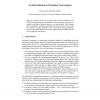IFM
2009
Springer
15 years 6 months ago
2009
Springer
IFM
2009
Springer
15 years 6 months ago
2009
Springer
In current model-driven development approaches, software models are the primary artifacts of the development process. Therefore, assessment of their correctness is a key issue to e...
107
Voted
IFM
2009
Springer
15 years 6 months ago
2009
Springer
Abstract. Service-oriented computing has emerged as a new programming paradigm that aims at implementing software applications which can be used through a network via the exchange ...
104
Voted
IFM
2009
Springer
15 years 6 months ago
2009
Springer
We present the new technique of dynamic path reduction (DPR), which allows one to prune redundant paths from the state space of a program under verification. DPR is a very general...
ICFEM
2009
Springer
15 years 6 months ago
2009
Springer
It is believed that reusability in formal development should reduce the time and cost of formal modelling within a production environment. Along with the ability to reuse formal mo...
FORMATS
2009
Springer
15 years 6 months ago
2009
Springer
Abstract. We study the realizability problem for specifications of reactive systems expressed in real-time linear temporal logics. The logics we consider are subsets of MITL (Metr...
108
click to vote
FORMATS
2009
Springer
15 years 6 months ago
2009
Springer
Embedded real-time systems are typically programmed in low-level languages which provide support for event-driven task processing and real-time interrupts. We show that the model c...
87
Voted
FORMATS
2009
Springer
15 years 6 months ago
2009
Springer
In concurrent real-time processes, the speed of individual components has a double impact: on the one hand, the overall latency of a compound process is affected by the latency of...
94
Voted
FORMATS
2009
Springer
15 years 6 months ago
2009
Springer
Recently, the model of weighted timed automata has gained interest within the real-time community. In a previous work, we built a bridge to the theory of weighted automata and intr...
69
Voted
FORMATS
2009
Springer
15 years 6 months ago
2009
Springer


